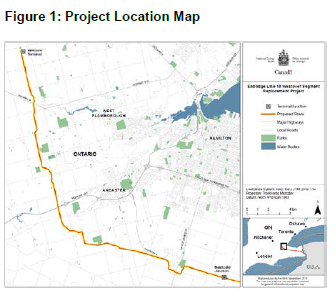Facilities Application – Pipelines
The Proposed Project
On 4 December 2015, Enbridge Pipelines Inc. (“Enbridge”) filed an application (the “Application”) with the NEB seeking approval to replace an existing section of the Line 10 Pipeline (the “Project”).
The Project includes the decommissioning of approximately 32 km of existing 323.9 mm outside diameter (“OD”) pipe (the “Existing Line”) and replacing it with approximately 35 km of new 508 mm OD pipe (the “Replacement Line”). The Project extends from Enbridge’s Westover Terminal to its Nanticoke Junction Facility, both near the City of Hamilton, Ontario.
Enbridge described the Project as a routine maintenance project designed to restore a section of pipe to its original annual capacity of 11,797 m3/day. In addition, the Project is intended to alleviate landowner concerns related to increasingly frequent maintenance digs associated with the Existing Line.
NEB Decision
For the reasons summarized below, the NEB found the Project to be in the public interest, subject to:
a) 32 terms and conditions regarding the construction of the Replacement Line; and
b) 14 terms and conditions regarding the decommissioning of the Existing Line.
Economic Feasibility
No participants commented on or objected to the Project being necessary or economically feasible.
Enbridge submitted that the Existing Line has reached its conservative threshold for replacement and should be replaced rather than undergo a program of further digs, inspection and routine maintenance.
Enbridge stated the capital cost of the Project is approximately $219 million and is financed through a commercial agreement with a third-party customer.
The NEB stated that it was satisfied with the economic feasibility and available financing for the Project. The NEB found that that there is a sufficient market to absorb the volumes of crude oil that would be delivered off the Replacement Line.
Construction of Replacement Line
The NEB approved the general design of the Project facilities as appropriate for the intended use and that the facilities would be constructed in accordance with widely accepted standards for design, construction, and operation.
Decommissioning of Existing Line
The NEB approved Enbridge’s approach to decommissioning of leaving the Existing Line in-place. However, the NEB imposed a condition requiring Enbridge to apply for leave to abandon the Existing Line once the Replacement Line is completed.
Environmental and Socio-Economic Impacts
Because the proposed Project is under 40 km in length, it is not considered a designated project under the Canadian Environmental Assessment Act, 2012 (the “CEAA 2012”). Therefore, the CEAA 2012 does not require an environmental assessment under that act. However, the NEB will still consider environmental protection as part of its broader mandate under the NEB Act.
Specifically, the NEB completed an Environment and Socio-Economic Assessment (“ESA”) as part of its review of the Project. The ESA considered both the decommissioning of the Existing Line and the construction and operation of the Replacement.
The NEB held that with the implementation of Enbridge’s proposed environmental protection mitigation measures, as well as certain NEB imposed conditions, the Project is not likely to cause significant adverse environmental effects.
Consultation
The NEB concluded that Enbridge’s design and implementation of its Project-specific public and Aboriginal engagement activities were appropriate for the scope and scale of the Project.
The NEB found that all Aboriginal groups potentially affected by the Project were provided with sufficient information and opportunities to make their views about the Project known to Enbridge and to the NEB.




